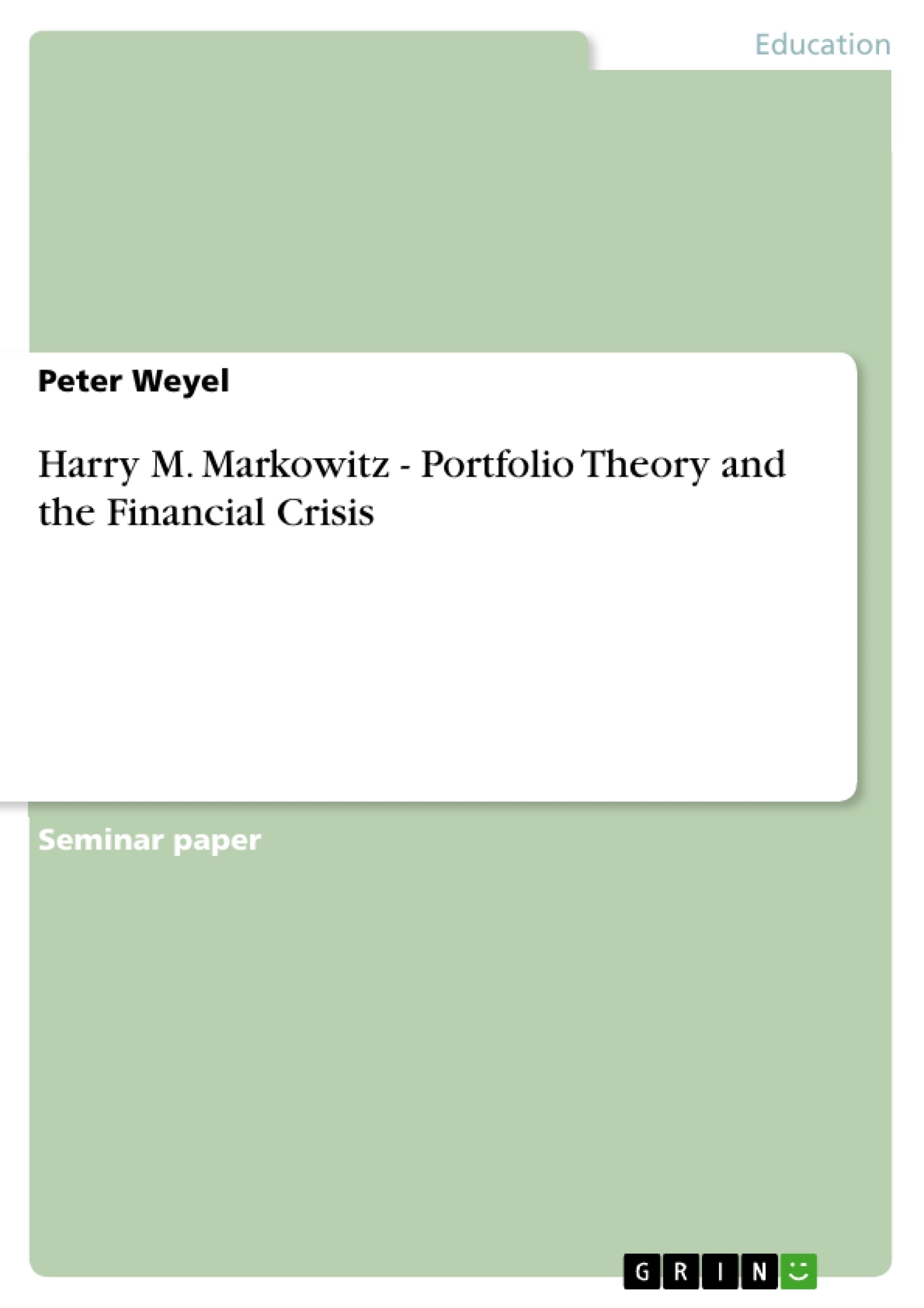This seminar paper explains Markowitz's Portfolio Theory in a consolidated and understandable way.
The principles of the Portfolio Theory are connected to the Financial Crisis that started as a bursting real-estate bubble in 2006. In this connection, it is shown that on the one hand the basic principles of Markowitz apply and might have helped to lower the extent of the crisis. On the other hand, the Risk-Return-Paradoxon which supported the evolution of the crisis is discussed.
Inhaltsverzeichnis (Table of Contents)
- Introductory Biography of Harry M. Markowitz
- The Portfolio Theory
- Risk and Return
- Diversification
- Relation to the Financial Crisis
Zielsetzung und Themenschwerpunkte (Objectives and Key Themes)
This seminar paper aims to provide an overview of Harry Markowitz's portfolio theory and its relevance to the financial crisis. It explores the life and work of Markowitz, detailing his contributions to the field of finance. The paper then delves into the core tenets of his portfolio theory, focusing on the relationship between risk and return.
- The life and academic contributions of Harry M. Markowitz
- The fundamental principles of Markowitz's portfolio theory
- The relationship between risk and return in investment decisions
- The application of portfolio theory to real-world investment strategies
- The relevance of portfolio theory in understanding the financial crisis
Zusammenfassung der Kapitel (Chapter Summaries)
Introductory Biography of Harry M. Markowitz: This chapter details the life and career of Harry Markowitz, highlighting his early interests in physics and philosophy, his academic pursuits at the University of Chicago, and his work at the Cowles Commission and RAND Corporation. It emphasizes his pivotal role in developing portfolio theory, his contributions to SIMSCRIPT, and the recognition he received, culminating in the Nobel Prize in Economics. The chapter provides a biographical context for understanding the development and impact of his influential work in finance.
The Portfolio Theory: This chapter presents the core tenets of Markowitz's portfolio theory. It explains the inseparable link between risk and return in security investments, illustrating how securities with higher variance tend to have higher mean values. The chapter discusses the mathematical underpinnings of the theory, including the use of standard deviation as a measure of risk, and clarifies the concept of expected return. A concrete example involving two hypothetical companies, SAVE Ltd. and RISKY Ltd., is provided to illustrate the investment decision-making process considering risk and return.
Schlüsselwörter (Keywords)
Portfolio theory, risk, return, diversification, Harry Markowitz, financial crisis, investment decisions, expected return, standard deviation, volatility.
Frequently Asked Questions: A Comprehensive Language Preview of Harry M. Markowitz's Portfolio Theory
What topics are covered in this language preview?
This preview offers a comprehensive overview of Harry M. Markowitz's portfolio theory. It includes an introductory biography of Markowitz, a detailed explanation of his portfolio theory (including risk and return, and diversification), an analysis of the theory's relevance to the financial crisis, chapter summaries, and key terms.
What is the purpose of this document?
This document aims to provide a structured and professional analysis of Harry Markowitz's portfolio theory, suitable for academic use. It serves as a preview, offering key information for understanding the complete work.
What is covered in the introductory biography of Harry M. Markowitz?
The biography details Markowitz's life and career, highlighting his early interests, academic pursuits at the University of Chicago, work at the Cowles Commission and RAND Corporation, his development of portfolio theory, contributions to SIMSCRIPT, and his Nobel Prize in Economics. It provides context for understanding his work's development and impact.
What are the core tenets of Markowitz's portfolio theory explained in this preview?
The preview explains the fundamental relationship between risk and return in security investments. It demonstrates how securities with higher variance tend to have higher mean values, discusses the mathematical underpinnings using standard deviation as a risk measure, clarifies expected return, and provides an example illustrating investment decision-making considering risk and return.
How does this preview relate Markowitz's portfolio theory to the financial crisis?
While the preview provides an overview of the theory, its connection to the financial crisis is mentioned as a key theme and area of exploration but not detailed extensively in this preview.
What are the key themes explored in this language preview?
Key themes include the life and academic contributions of Harry M. Markowitz, the fundamental principles of his portfolio theory, the relationship between risk and return, application of portfolio theory to real-world investment strategies, and its relevance to understanding the financial crisis.
What are the keywords associated with this material?
Keywords include: Portfolio theory, risk, return, diversification, Harry Markowitz, financial crisis, investment decisions, expected return, standard deviation, volatility.
What is the structure of the provided document?
The preview is structured with sections for the table of contents, objectives and key themes, chapter summaries, and keywords. This provides a clear and concise overview of the subject matter.
- Quote paper
- Dipl. Kfm. Peter Weyel (Author), 2009, Harry M. Markowitz - Portfolio Theory and the Financial Crisis, Munich, GRIN Verlag, https://www.grin.com/document/170556



